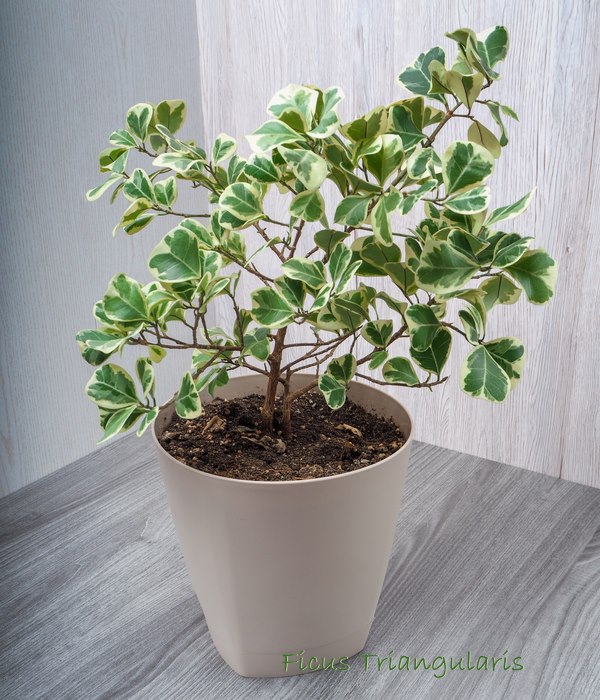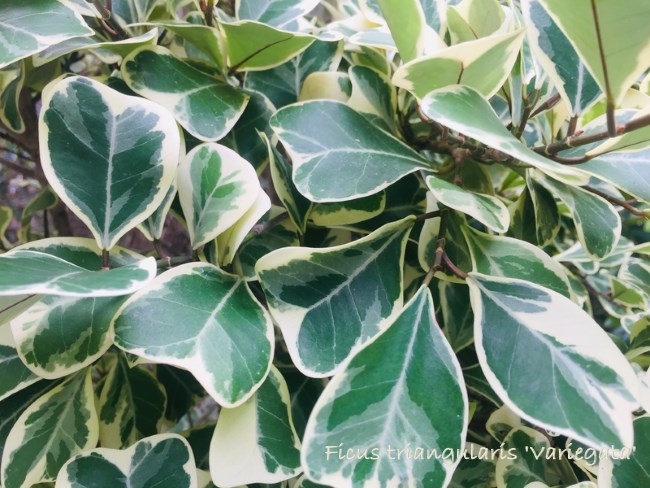
Variegated Ficus triangularis delivers dramatic leaf patterns, making this good-looking houseplant showy sufficient to show by itself. Set a younger plant on a desk, then because it matures, let it shine as a flooring plant.
It is also simple to develop, giving us a brand new favourite from the fig household. It is excellent for newcomers.
Get to Know Triangleleaf Fig
Shrubby Ficus triangularis gives a riot of coloration, texture, and kind multi function. Naturally compact, it makes a wonderful indoor plant.
Gradual-growing, it’s going to ultimately attain a number of toes tall, however you possibly can prune it as a lot as you need to management its measurement. Spring is the very best time to prune, when your plant is starting its most vigorous time of progress.
This extremely decorative shrub is generously coated with foliage, distinctly triangular-shaped with rounded edges. ‘Variegata’ is a sought-after cultivar for its beautiful variegated inexperienced leaves with creamy white edges.
Does it develop figs indoors? Sure, this is likely one of the few Ficus species that produces fruit indoors, though the figs are tiny and never edible.
Ficus Issues, Options and Solutions
Questioning when to repot? Transfer your plant up one measurement (1 to 2 inches) when its roots are coiled within the pot or rising out the drainage holes. Use a heavy container for bigger crops to assist steadiness its weight. Tall crops are top-heavy. Repot in spring. Discover out methods to repot houseplants right here.
One thing bugging your plant? Look ahead to scale bugs and mealybugs that will infest Ficus crops. Look alongside the stems and undersides of leaves, the place they like to cover. Isolate an infested plant and deal with it immediately with insecticidal cleaning soap.
Yellow, drooping leaves are a symptom of over-watering. One factor this plant will not tolerate is soggy potting combine. Use a pot with drainage holes and empty drainage tray after watering. See “Water” suggestions beneath.
Dropped leaves are possible a results of low mild ranges or a sudden change in mild. Ficus triangularis is not as temperamental as its member of the family, the weeping fig, but it surely would not like change in mild, temperature or …properly, any change. Take care to not over-water a Ficus that is dropping leaves as a result of that will make the issue worse. Elevating the humidity round it could assist.
Are Ficus crops toxic? Sure, the sap is poisonous to pets if eaten. It may well trigger pores and skin and eye irritation for individuals who are available contact with the sap. As a precaution, it is a good suggestion to put on gloves when pruning or repotting this plant.
 Bordered with white, the inexperienced sample is heart-shaped. Photograph © Wipavadee Boonyatha
Bordered with white, the inexperienced sample is heart-shaped. Photograph © Wipavadee BoonyathaFicus Triangularis Care
Origin: Southeast Asia
Top: 4 to six ft (1.2 to 1.8 m)
Mild: Vibrant, oblique mild year-round. Crops that do not develop a lot, are dropping leaves, or lose their variegation, most likely don’t get sufficient mild.
Water: Water completely, then enable to dry out barely between waterings. Ficus won’t tolerate soggy soil. Preserve soil barely drier in winter, when mild ranges are decrease and progress is slower. Yellow leaves are a symptom of overwatering.
Humidity: Relative humidity ranges as much as 70% are greatest for Ficus triangularis. It is a good suggestion to make use of a humidity gauge close to your plant, quite than guess, as a result of indoor air can change into extraordinarily dry through the winter months with out our noticing it. The most effective solution to enhance humidity on your houseplant is with a cool-mist room humidifier.
Temperature: Common to heat room temperatures (65-85°F/18-29°C). Ficus triangularis prefers heat temperatures like we do, however will tolerate a minimal of fifty°F/10°C. Preserve your plant away from chilly drafts and warmth/AC vents.
Soil: Soilless potting combine
Fertilizer: Feed as soon as a month spring via fall with a balanced water-soluble fertilizer. Or drop time-release fertilizer granules on high of the potting medium earlier than watering. Do not feed your houseplant in winter when progress is slower.
Propagation: Ficus triangularis roots simply from stem tip cuttings. Spring is the very best time to propagate cuttings as a result of this plant is starting its most vigorous time of progress. Take 3-inch (8 cm) tip cuttings with just a few leaves connected and place cuttings in potting medium, stored calmly moist and heat (round 70°F/21°C).